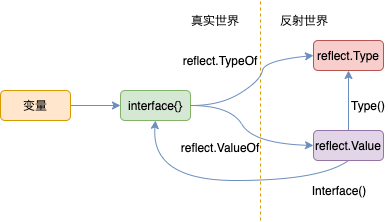Go 语言实现——反射¶
基本使用¶

reflect 包最重要的两个数据结构就是 Type 和 Value,定义如下:
type Type interface {
Align() int
FieldAlign() int
Method(int) Method
MethodByName(string) (Method, bool)
NumMethod() int
Name() string
PkgPath() string
Size() uintptr
String() string
Kind() Kind
Implements(u Type) bool
// ...
}
type Value struct {
// 类型指针
typ *rtype
// 数据指针
ptr unsafe.Pointer
flag
}
变量通过
reflect.TypeOf、reflect.ValueOf可以反射得到Type、Value。Type是一个接口,这个接口定义了获取类型信息的各种接口,Value是个结构体,这个结构体里保存了变量的数据信息,其字段都是私有,所以得通过结构体的方法来获取数据信息。Value调用自身的Interface()方法可以将数据再反射回原始数据(interface{} 类型,通过类型断言可以回到最原始的数据)。Value调用自身的Type()方法可以获得类型信息。
反射和 interface{}¶
从 Go 语言实现——数据结构 中关于 interface{} 的实现可以看出,interface{} 是 Go 类型信息的注入点,reflect.TypeOf 和 reflect.ValueOf 的入口参数类型都是 interface{}。
TypeOf 直接返回 interface{} 的类型指针。
func TypeOf(i interface{}) Type {
eface := *(*emptyInterface)(unsafe.Pointer(&i))
return toType(eface.typ)
}
func toType(t *rtype) Type {
if t == nil {
return nil
}
return t
}
type emptyInterface struct {
typ *rtype
word unsafe.Pointer
}
ValueOf 将 interface{} 的类型指针和数据指针封装在 Value 结构体中返回。
func ValueOf(i interface{}) Value {
if i == nil {
return Value{}
}
escapes(i)
return unpackEface(i)
}
func unpackEface(i interface{}) Value {
e := (*emptyInterface)(unsafe.Pointer(&i))
t := e.typ
if t == nil {
return Value{}
}
f := flag(t.Kind())
if ifaceIndir(t) {
f |= flagIndir
}
return Value{t, e.word, f}
}
静态类型(static type)和实际类型(underlying type)¶
The static type (or just type) of a variable is the type given in its declaration, the type provided in the new call or composite literal, or the type of an element of a structured variable.
var r io.Reader
tty, err := os.OpenFile("/dev/tty", os.O_RDWR, 0)
if err != nil {
return nil, err
}
r = tty
上面的代码中:
r的(静态)类型是io.Reader,Go 会在编译期作类型检查。io.Reader是一个 interface ,运行时它在内存中是一个iface结构体,这个结构体中的类型指针指向*os.File这个实际类型(不是io.Reader),数据指针指向tty。
因此,通过类型断言,我们还可以将 r 给转换成 io.Writer 类型。
var w io.Writer
w = r.(io.Writer)
方法¶
type Person struct{}
func (p Person) SayHello(message string) {}
func main() {
p := Person{}
fmt.Println(reflect.TypeOf(p.SayHello))
// 输出:func(string)
fmt.Println(reflect.TypeOf(Person.SayHello))
// 输出:func(main.Person, string)
}
Person.SayHello(Person{}, "me") 和 Person{}.SayHello("me") 这两个调用虽然是等价的,底层最终编译成的代码也是一样的,但是这两个类型是不一样的,一个是 未绑定方法(Unbounded method),一个是 绑定方法(Bounded method),这样通过 reflect.Value.Call 调用方法传参的时候就和正常调用一样,未绑定方法需要传需要绑定的对象,而绑定方法不用。
实现方法就是绑定方法的 reflect.ValueOf(p.SayHello) 里包含了指向绑定对象的指针和一个适配函数,通过适配函数来完成额外的绑定对象这个参数的传递,详细参见: https://golang.org/s/go11func 。
使用场景一:修饰器 Decorator¶
以修饰 nats.io 消息队列客户端的 Conn.Subscribe 函数的回调处理函数为例,这类处理函数一般都是先解码请求、处理请求生成响应、编码响应这个流程。
nc.Subscribe("foo", func(m *nats.Msg) {
var reqeust requestType
json.Unmarshal(m.Data, &request)
var reply replyType
reply.X = "blahblah"
replyData, _ := json.Marshal(&reply)
m.Respond(replyData)
})
处理函数多了,每个函数都写一遍解码编码很麻烦,如果处理函数能够类似 rpc 处理函数一样,将编解码的部分抽出来,处理函数中直接处理请求 / 响应的结构体,写起来就会方便得多,类似下面这样:
nc.Subscribe("foo", makeRequestReplyHandler(func (request *requestType, reply *replyType) {
reply.X = "blahblah"
}))
上面的这个 makeRequestReplyHandler 修饰器需要用到 reflect 来实现:
func makeRequestReplyHandler(cb interface{}) nats.MsgHandler {
f := reflect.ValueOf(cb)
typ := f.Type()
if typ.Kind() != reflect.Func {
panic("not a function")
}
numParams := typ.NumIn()
if numParams != 2 {
panic("invalid param number")
}
reqType := typ.In(0)
replyType := typ.In(1)
if reqType.Kind() != reflect.Pointer || replyType.Kind() != reflect.Pointer {
panic("invalid request/reply type")
}
return func(m *nats.Msg) {
req := reflect.New(reqType.Elem())
reply := reflect.New(replyType.Elem())
json.Unmarshal(m.Data, req.Interface())
f.Call([]reflect.Value{req, reply})
replyData, _ := json.Marshal(reply.Interface())
m.Respond(replyData)
}
}
最后,通过 reflect.MakeFunc 函数还能实现更复杂的泛型的修饰器,详细可以参考: https://coolshell.cn/articles/17929.html#泛型的修饰器
